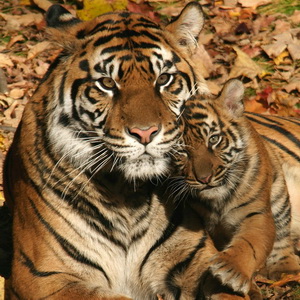Phylum: Chordata
Subphylum: Vertebrata
Class: Mammalia
Order: Carnivora
Family: Felidae
This is the beginning of the taxonomy of the tiger. The family of Felidae is broken down into three subfamilies. Tigers are a member of the subfamily Pantherinae. Within this subfamily is the tiger's genus, Panthera. The other members of this genus are lions, leopards, and jaguars. All of these cats share the ability to roar. Even the species of tiger can be broken down into eight subspecies, five of which are still alive today. According to the fossil record, Miacoids are the tiger's oldest ancestors. These were tree-dwelling cats, much smaller than the big cats of today.
The oldest cat is the Proailurus, dated to around 30 million years ago. However, it was around 20 million years ago when the Pseudaelurines appeared. These are the cats considered to be the direct ancestors to all modern cats.
Within their genus, lions, jaguars, and leopards all have more in common with each other than they do with the tiger. This indicates that the tiger probably diverged in the evolutionary tree earlier than the other members of its genus.
The recent discovery of a skull 2.5 million years ago that relates to the modern cat showed that tigers have not evolved all that much. The skull was extremely similar to that of a modern tiger, proving that the tiger was such a well-equipped predator from the beginning that not many adaptations were necessary. This goes to show that what we talked about in class is true. Evolution is not about becoming more and more advanced, it's about finding what works in an environment and sticking with it.
Resources:
















